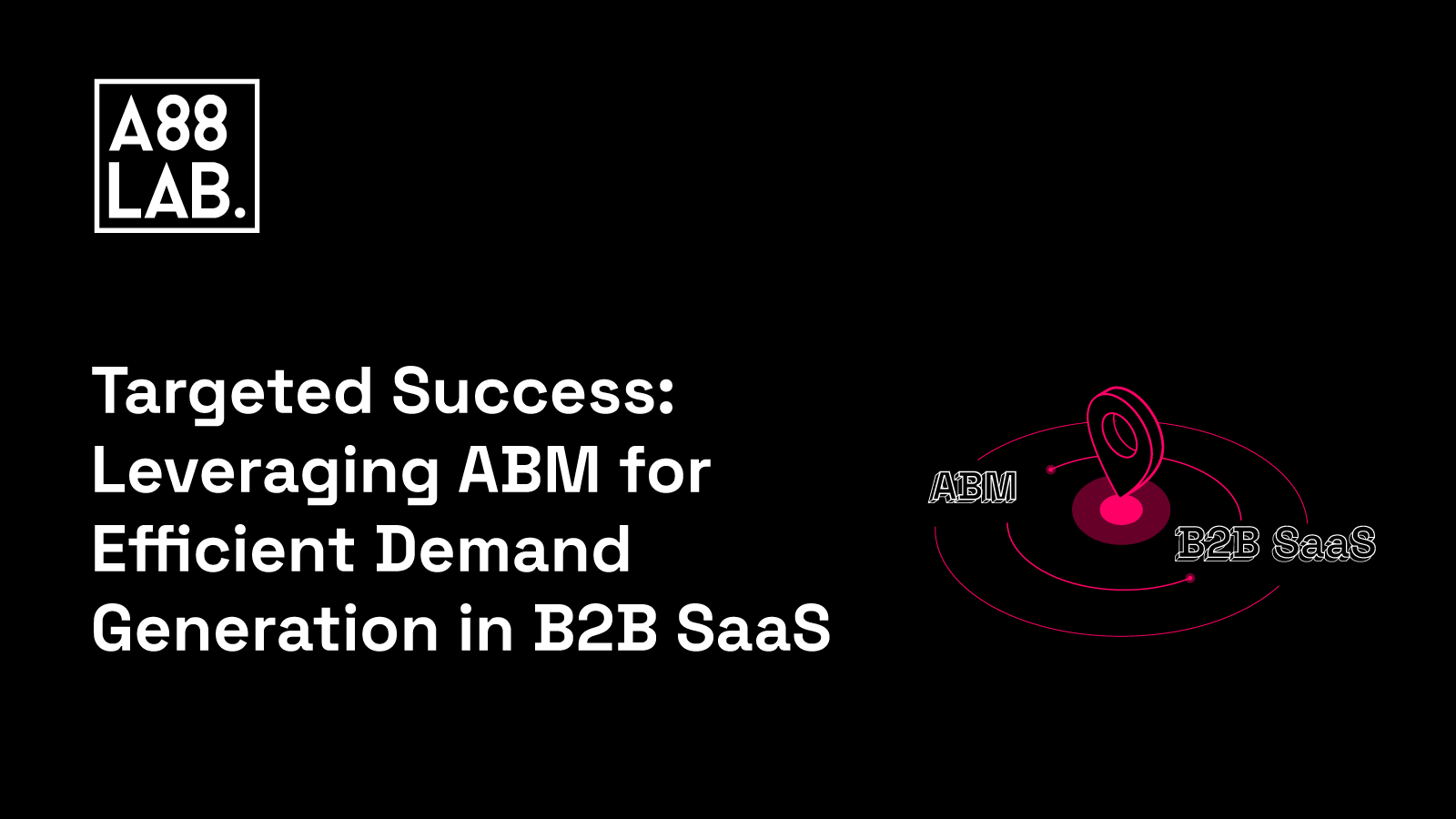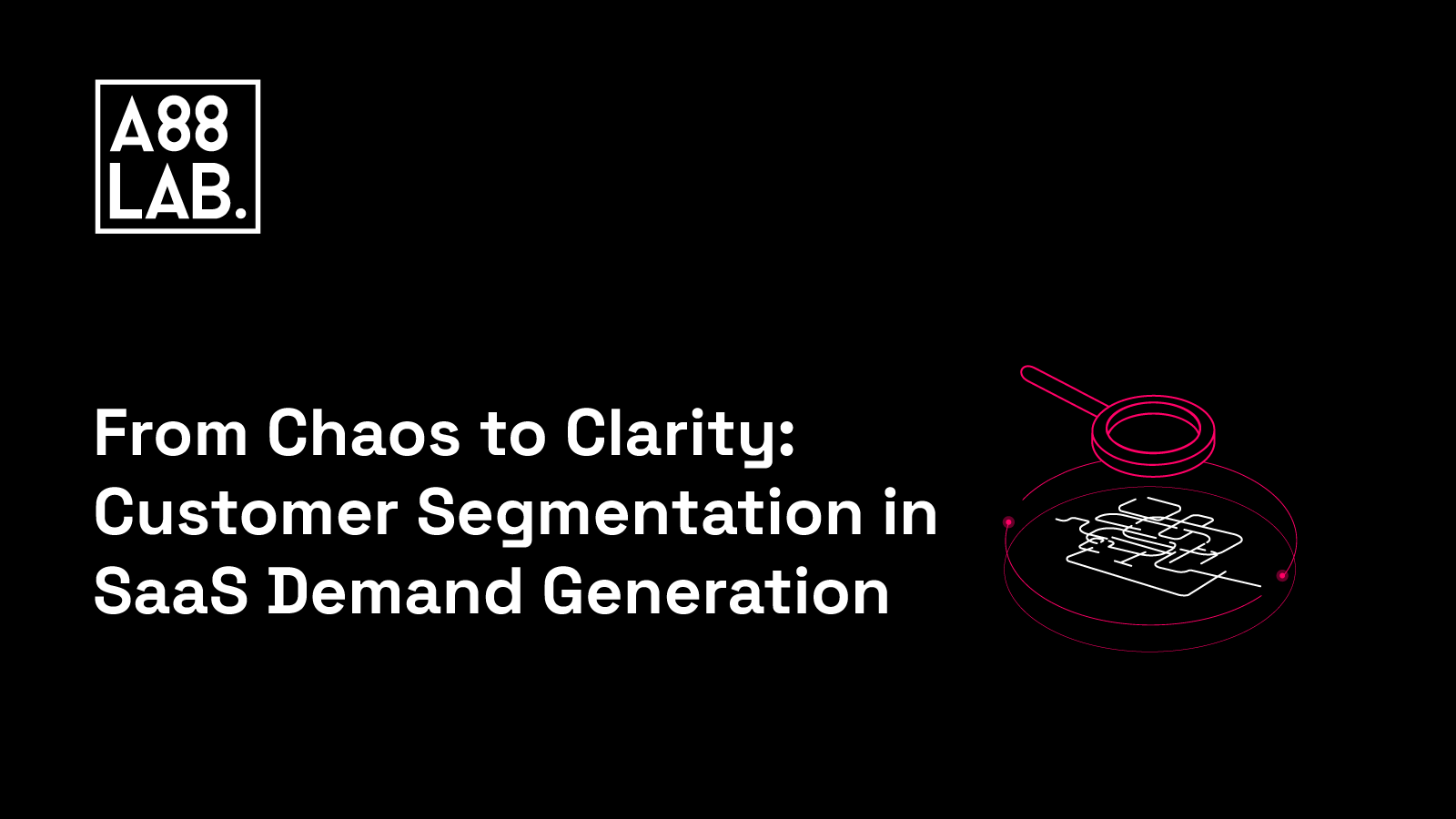Did you know that according to a report by HubSpot, 67% of B2B brands leveraged account-based marketing (ABM) in 2021? The reason for this increased popularity is simple – it works.
But what makes ABM so effective for B2B demand generation?
Account-based marketing involves targeting specific accounts rather than a generic group of prospects. With ABM, you get the opportunity to create a personalized marketing strategy that reaches out and engages your most valuable accounts. Think of it this way: if lead generation is fishing with a net, ABM is fishing with a spear.
It allows you to start the sales process by selling directly to your best-fit, highest-value accounts instead of trying to sell to everyone and hoping for the best. By weeding out less-valuable accounts and prioritizing the ones with the highest potential for success, ABM ensures marketing and sales teams work in tandem to achieve maximum ROI.
In this blog post, we aim to challenge the various misconceptions surrounding ABM in B2B demand generation. We will discuss if ABM's strategy is similar to or the complete opposite of traditional demand generation and explore how these two tactics can work together toward the same goal: getting more customers.
Demand Gen and ABM Are Marketing Cousins, but Not Twins
Before diving into ABM and demand gen definitions, it's essential to recognize a close connection between the two. After all, many B2B companies use both tactics to reach and engage potential customers.
ABM and demand gen may look like opposites at first glance. However, upon closer examination, some similarities stand out:
- Both strategies aim to target the right prospects and accounts
- Both generate conversions by providing valuable content that resonates with their audiences
- Both filter their leads and accounts, then nurture them through the sales process
- Both require a deep understanding of customers and their needs
However, despite these similarities, there are some notable differences between demand gen and ABM. Let's explore them in the table below:
|
Demand Generation |
ABM |
|
|
|
|
|
|
|
|
|
|
|
|
Once you understand the key differences and similarities between demand gen and ABM, you can begin to explore how both strategies work together.
Ways to Implement an ABM Campaign Into Demand Generation Strategy for SaaS
Let's start by looking at ways to integrate ABM into your demand generation strategy. Think of it as a symbiotic approach where ABM complements and enhances your existing demand gen efforts.
While these two approaches have unique characteristics and objectives, let's not forget they are highly complementary. A well-executed demand generation strategy sets up a viable pool of potential prospects, creating awareness and generating initial interest in the target market.
Then, ABM comes into play by narrowing the field and selectively targeting the highest-value customers within the established pool. This combined approach allows ABM to engage customers at different buyer journey stages within the marketing funnel. Demand generation creates initial awareness and consideration, while ABM takes over to nurture and convert those prospects into valuable customers.
To incorporate ABM into your demand generation strategy, it's crucial to understand how its strategies work. At its core, ABM filters leads and concentrates solely on qualified accounts. Instead of fishing for prospects, you strategically target and engage the perfect accounts.
We can divide ABM into two key stages:
- Awareness: During this stage, the focus is on top-of-the-funnel content aimed at cold or new accounts. It's an opportunity to provide valuable content, such as ebooks or webinars, which offer insights and solutions relevant to these target accounts.
- Engagement: In the engagement stage, the focus shifts to bottom-of-the-funnel activities such as product demonstrations or offering free trials. The goal is to entice reluctant accounts by sweetening the deal or providing a deeper offer. This stage requires delivering content that converts, such as competitive comparison reports or trials, as brand familiarity is already established.
Furthermore, ABM accounts can be categorized into different tiers based on the Ideal Customer Profile (ICP). Dividing accounts into tiers ensures that marketers focus their efforts on accounts that align with their target criteria, ultimately saving resources and increasing the chances of securing sales.
The tiers of ABM accounts typically include:
- Strategic Accounts: These are high-value accounts that have significant revenue potential. They require a highly personalized and dedicated approach to build strong relationships and drive growth.
- Key Accounts: Key accounts have moderate revenue potential and are also important for business growth. They receive a personalized marketing approach but may not require the same level of resources as strategic accounts.
- Target Accounts: Target accounts are prospects that fit the ICP and have the potential to become valuable customers. They are prioritized for marketing efforts but may not receive the same level of personalization as strategic or key accounts.
For B2B SaaS companies, demand generation and ABM are a match made in heaven. While demand geen focuses on building a pool of potential customers, ABM helps to identify the best prospects and move them through the funnel. With this integrated approach, marketers can better target prospects, engage customers and drive growth.
The important part is that your ABM strategy needs to be complementary to your demand gen efforts to maximize their effectiveness. You can't just abandon the strategies that have been working for you and completely change the narrative or messaging to focus solely on ABM.
Instead, for best results, you should leverage both and blend them together to create a more holistic approach that will drive results. With the right combination of demand generation and account-based marketing strategies, you can create a powerful B2B marketing strategy that will drive lasting results.
The Future of Account-Based Marketing in Demand Generation
As marketing technology and data-driven strategies become even more prevalent and companies recognize the effectiveness of ABM in enhancing their existing efforts, several key trends are shaping its future:
Increased adoption: ABM is quickly gaining traction and becoming more mainstream. As marketers continue to see the value of its strategies, we expect that adoption will rise as companies seek to optimize their marketing efforts.
Greater integration with other demand generation tactics: As ABM continues to evolve, marketers are beginning to find ways to integrate it with existing demand generation practices, such as inbound and outbound marketing, referral marketing, and event marketing.
Enhanced personalization: As artificial intelligence and machine learning become more common, the ability to personalize content and messaging to specific accounts is becoming more accessible.
Greater emphasis on the customer experience: Much of the focus in ABM is on engaging customers and providing them with a personalized experience. As marketers become more aware of customer needs and expectations, we expect that focus to become even more prominent.
The Significance of Demand Generation
Before you jump on the ABM bandwagon, it's important to remember that demand generation is still an essential part of any successful B2B marketing strategy. Demand generation is an umbrella term that encompasses all the activities and strategies used to drive long-term customer engagement and brand-to-customer relationships.
While lead generation is often associated with demand generation, the scope of demand generation goes far beyond that. It focuses on establishing trust and building relationships, accelerating the sales pipeline, cutting CAC, and improving attribution efforts, all while emphasizing the quality of the generated opportunities. This means that the techniques used in demand gen are tailored to create relationships with buyers, laying the groundwork for long-term customer loyalty.
When it comes to activities that take part in demand gen, they can include everything from webinars and content marketing to audience research, podcasts, thought leadership efforts, email marketing, lead nurturing campaigns, remarketing ads, and social media engagement. Roughly speaking, we can divide these activities into three pillars:
Brand Awareness: This pillar involves attracting the right audience and introducing them to your company brand. It requires strategies such as creating compelling content, optimizing for search engines (SEO), leveraging pay-per-click (PPC) advertising, and utilizing intent data to target potential customers effectively.
Demand Capture: This pillar is all about converting prospects into high-quality opportunities. It involves activities such as email campaigns, lead scoring, and leveraging advanced analytics to identify buying signals and reach the right person within each account.
Pipeline Acceleration: This pillar is focused on ensuring that the opportunities identified by demand capture are nurtured through the sales pipeline as quickly and effectively as possible. It focuses on implementing strategies and tactics that facilitate the progression of prospects from the initial stages of awareness and interest to the final stages of consideration and purchase.
In B2B SaaS, demand gen is a critical component of the customer acquisition process. It allows companies to create and maintain relationships with prospects and customers, which can lead to more sales and greater customer retention in the long run.
That's not to say there are no disadvantages to demand gen. It can be expensive and time-consuming to implement, and it may not deliver immediate results. It can also be challenging to track and measure ROI on demand gen efforts, which makes it hard to justify costs. Finally, failing to align demand gen activities with your sales process can lead to wasted resources.
Which is exactly where ABM can add value.
ABM: Enhancing the Demand Gen Efficiency
As mentioned earlier, Account-Based Marketing is a targeted marketing strategy focusing on engaging and nurturing specific high-value accounts, rather than casting a wide net to attract a larger audience. ABM is customer-centric and tailored to each account's interests, with the aim of driving engagement and loyalty across multiple touchpoints.
In ABM, the marketing and sales teams work in close collaboration to identify key accounts, tailor personalized marketing campaigns, and drive meaningful interactions throughout the buyer's journey. This strategy helps to ensure that the right message is delivered to the right accounts at the right time, helping to accelerate sales cycles and increase customer loyalty.
Successful implementation of ABM relies on a few key components that contribute to its effectiveness:
Account Selection: Identifying High-Value Target Accounts
The first step in any ABM strategy is identifying and selecting target accounts that align with your ideal customer profile (ICP). These accounts are usually high-value prospects with the potential for significant revenue generation. Careful consideration of factors such as their revenue potential, industry fit, growth opportunities, and strategic importance will help you determine the best target accounts for your ABM efforts.
Account Research: Understanding Target Accounts
Now that you have identified targeted accounts, you must conduct thorough research to engage them effectively. That involves gaining a deep understanding of their pain points, goals, challenges, and decision-making processes.
The best way to conduct these kinds of research is through methods like customer interviews, surveys, social media listening, and online behavior analysis. These insights will help you tailor messaging and content specific to the needs of each account.
Personalized Messaging: Tailoring Messages for Each Account
ABM emphasizes delivering personalized and relevant messages to key decision-makers within the target accounts. By customizing messages to address each account's unique pain points and interests, you can increase the chances of effectively engaging them.
But, personalization extends beyond content. It also includes the timing of messages and even the mediums used, as each account will likely have different channel preferences.
Multi-channel Engagement: Leveraging Various Channels for Outreach
ABM employs a multi-channel approach to engage target accounts across different touchpoints. This involves leveraging channels like email, social media, content marketing, events, and personalized outreach. Each channel serves a specific purpose and is strategically used to deliver a cohesive brand experience, reinforce key messages, and maintain consistent communication with the target accounts.
Analytics and Reporting: Tracking and Measuring Campaign Results
The last, but no less important, piece of the ABM puzzle is tracking progress and measuring campaign success. This involves gathering and analyzing data from different channels, such as website visits, social media activity, email open rates, etc. It will help you to identify what's working and what can be improved and enable data-driven decision-making to optimize future ABM campaigns.
Conclusion
Overall, ABM's future looks bright. As more companies adopt its strategies and find ways to integrate them into their existing marketing efforts, ABM will continue to be a powerful force in the B2B demand generation space.
While some people are still skeptical of ABM, thinking of it as just another buzzword and claiming their sales and marketing team will never be aligned enough to implement it successfully, the truth is they probably don't know enough about it or have been scared away by the complexity of other demand generation strategies.
The good news is that ABM can be implemented quickly and easily, and its power should not be underestimated. As more companies adopt a combination of demand gen and account-based marketing tactics, they will quickly realize the potential for growth that ABM offers, not only in terms of sales and revenue but also in terms of customer loyalty and satisfaction.
.png)


